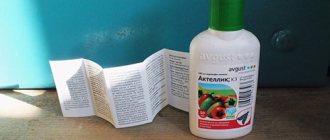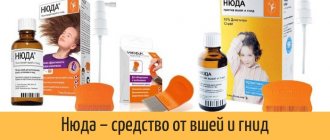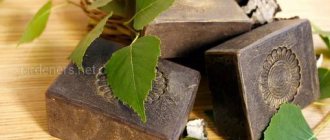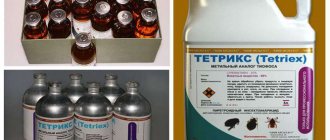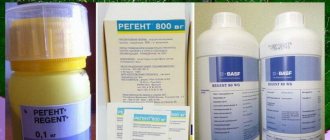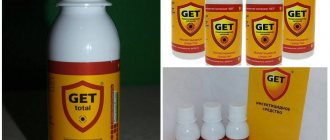Composition and release form
This product is produced by Russian. You can find the insecticide on sale in the form of a concentrated EC emulsion. The drug can be packaged in bottles with or without dispensers, or sold in 1 or 5 ml ampoules intended for single use.
The effectiveness of the Alatar insecticide is due to the presence of two active components in its composition:
- malathion, which is an organic phosphate compound. The substance has a toxic effect on most insects that parasitize plants;
- cypermethrin is a fast-acting pyrethroid substance that promotes the development of paralysis in pests.
The insecticide contains surfactants that increase the effectiveness of the active components, as well as additional substances - stabilizers, solvents, antioxidants.
Chemical composition of Alatar and purpose of the drug
The main active substances included in the insecticide Alatar are malathion (22% of the total mass of the drug) and cypermethrin (5%), surfactants, antioxidants, stabilizers and solvents.
This product is produced in the form of a liquid concentrate of the drug; it goes on sale in ampoules with a capacity of 5 ml and in bottles with a volume of 25 and 50 ml.
The main supplier of insecticide is Russian.
Malathion (or karbofos) is a broad-spectrum organophosphorus compound.
Thanks to this active substance, the insecticide successfully fights aphids on plants, and can also prevent mass invasions of other pests, including mites.
Cypermethrin is a contact-intestinal insecticidal active substance.
It paralyzes adults and their larvae without affecting the eggs. And the special adhesives included in the Alatar preparation do not allow the insecticide solution to roll off the leaf plates after treatment or be washed off by the rain immediately after spraying.
The drug Alatar is systemic and effectively copes with “harmful” bugs on the following garden and vegetable crops:
- cabbage;
- carrots;
- onion;
- fruit trees;
- berry crops;
- strawberries;
- garden flowers;
- coniferous trees and shrubs;
- ornamental plants.
Photo of the drug Alatar
The instructions for use of Alatar say that this insecticide effectively copes with the following types of pests:
- whiteflies;
- Colorado potato beetle and its larvae;
- scoops;
- all types of aphids;
- codling moth;
- leaf rollers;
- copperhead;
- psyllids;
- vegetable moth;
- plant flies;
- weevils;
- sawflies and a number of similar insects.
Good to know!
Experts believe that when treating garden and vegetable crops against aphids, Alatar is considered one of the best insecticides, destroying at least 90% of pests after one spraying.
Mechanism of action on pests
Due to the presence of two active ingredients in the composition, once the drug Alatar enters the intestines of a pest or larva, damage to their nervous system and paralysis occurs. Losing the ability to move and feed, the pests die.
And since the insecticide contains moisture-resistant additives that promote the adhesion of active substances to the stems and leaves of plants, its effect does not stop even after heavy rains or watering.
The active substances do not lose their properties under the influence of sunlight, high and low temperatures, and continue to have a detrimental effect on pests for a long time. This allows you to quickly improve the health of the area with just one treatment.
The effectiveness of the drug and its advantages
This drug does not affect insects immediately - usually insects stop eating after this toxic agent enters their body, then paralysis begins, and the complete death of the bugs occurs two days after contact with the insecticide.
Typically, plants are protected with Alatar for up to 3 weeks. It is possible to determine that the effect of the drug on beetles has ended if the pests reappear on the plants. In this case, another spraying against pests should be carried out.
This insecticide has the following positive qualities:
- Alatar is effective against pests that are resistant to many other chemicals;
- synergistic effect;
- is not washed off from the foliage by rain;
- drops of the working solution remain on the leaf plates and do not roll off during spraying;
- the drug does not decompose into components when exposed to sunlight;
- Alatar protects plants from pests for 3 weeks.
Alatar protection against pests - video
Advantages and disadvantages
Alatar has the following advantages:
- wide spectrum of action;
- high speed of impact;
- low likelihood of developing resistance;
- Possibility of use up to 2 times during the season;
- a long protective period, which is achieved thanks to the adhesives contained in the Alatar insecticide;
- resistance of active components to the sun and low temperatures;
- Resistant to washing away by rain.
Insecticide Alatar - analogues
Analogues of this insecticide are other products that contain malathion or cypermethrin:
- Alioth;
- Anti-mite;
- Carbocin;
- Karbofos-500;
- Fufanon;
- Cipromal;
- Arrivo;
- Spark;
- Ram;
- Alfatrin and a number of other drugs.
Instructions for use and consumption rates
To prepare the working solution, you need to pour 2-3 liters of water into a bucket (10 l), and add the contents of 1 ampoule with a volume of 5 ml to the water, and then bring the bucket to its full volume (10 l). The solution is mixed well and poured into the sprayer tank.
You need to know that some plants require higher dosages, while others require lower dosages. Therefore, before you start spraying the drug on plants, you need to study the standards for each of them.
Cabbage, potatoes, onions, carrots
Spraying of the listed crops is carried out during the growing season. The working fluid is prepared at the rate of 25 ml per 20 liters of water. For a garden of 100 m², 4 liters of ready-made solution are used.
Spraying cabbage with Alatar promotes the effective destruction of cabbage moths, thrips, white flea beetles, and leaf flea beetles.
Potatoes are sprayed only in case of mass infestation of bushes with potato moths, Colorado potato beetles, and ladybugs. The application rate for this crop is 4 liters of working solution per 100 m².
The same scheme is used for processing carrots and onions in order to destroy onion flies and carrot psyllids.
Apple tree
To combat pests that attack apple, quince, and pear trees, prepare a solution from one ampoule (5 ml) of the Alatar insecticide and 10 liters of water. This amount is enough to spray two mature, medium-sized trees. One young tree requires 3 liters of solution, and mature tall spreading trees require up to 7 liters.
Using an insecticide in an orchard allows you to get rid of aphids, moths, moths, sawflies, and leaf rollers. Spraying is carried out during the growing season.
Currants, strawberries
Currants and gooseberries are treated with Alatar solution, for the preparation of which you need to dilute 5 ml of the product in 5 liters of water. 1 bush requires about 1 liter of working fluid.
To control strawberry pests, prepare a solution of 5 ml of the drug and 4 liters of water. This quantity is calculated for an area of 100 m². Treatment is carried out during the growing season. The pesticide allows you to quickly destroy the raspberry-strawberry weevil and many other insects.
How the work is carried out
To make a solution, take 1 ampoule of liquid, dilute it in 1 liter of water, and stir. Next, add another 9 liters of water. Crops are sprayed in the morning or evening, make sure that the weather is calm, without sharp gusts of wind.
Vegetables. Potato. You will need 10 liters of diluted insecticide per 100 m2. Cabbage is sprayed throughout the growing season. The consumption is similar to that for potatoes. Carrot flea beetles are most effectively destroyed in June. Spraying carrots is carried out once - 4 liters of ready-made solution are needed per 100 m2. To get rid of onion flies, you need to treat the onions with the same amount as carrots, and repeat the procedure after three weeks.
Berry bushes. Spraying strawberries, raspberries, gooseberries, and currants should be carried out especially carefully. Perform one procedure at a rate of 5 ml per 4 liters of water. The drug is effective against all pests of berry plants. The session is carried out once, a month before fruiting.
Gooseberries and currants - you need to dilute 1 ml in 1 liter of water. The procedure is carried out once during the growing season, a month before the start of fruiting. On average, one liter of solution is needed per bush.
Fruit trees. Apple trees, pears and other fruit crops are most often parasitized by codling moth, sawfly, apple moth, aphid, hawthorn, and leaf roller. You need to spray in the summer, three weeks before picking the fruit. To treat one tree, you need approximately three liters of a diluted solution - 5 ml per 10 liters of water. If the degree of damage to the crop is significant, the consumption of the drug is doubled.
Fruit bushes. The processing procedure is needed at the stage when young leaves just begin to appear. Do not use during budding, a month before the start of active fruiting, maintaining a consumption of 5 ml per 4 liters of water.
Garden and indoor plants, ornamental shrubs. You need to dilute a five-millimeter ampoule in 10 liters of water. One spray is enough for three months. If the foliage and stems are significantly affected by insects, an additional procedure will be needed after 21 days.
Treatment of indoor flowers and green spaces is carried out, if possible, in the open air; you must first take the plants outside. If this is not possible, the room should be well ventilated.
When is processing allowed?
Most insect pests appear in April, and massive damage to plants can be detected as early as mid-May. To avoid their massive spread throughout the area, it is recommended to take control measures in early April or at the end of March. Preventative treatment will destroy most insects and prevent their attacks on garden and vegetable crops. Repeated spraying is allowed during the period when fruit formation begins.
Treatment of ornamental plants is also carried out before they begin to bloom, in early spring. Berry bushes can be processed before the flowers form, or after harvesting. During the formation of berries, such plants, unlike vegetable crops, should never be sprayed.
Spraying of potatoes, cabbage, onions and carrots is carried out at the beginning of the growing season.
When can you eat vegetables after processing?
In case of massive damage to plants, which threatens their death, some gardeners and gardeners resort to spraying during fruit formation. Since the active ingredient of the drug Alatar is capable of penetrating into the fruits, it is not recommended to use this product during their formation.
Instead of an insecticide, it is better to use safer products - biological products, infusions of onion or garlic peels, mustard powder or wormwood decoction.
If folk remedies and biological products do not provide the desired results, plants can be sprayed with Alatar during fruit set. The decay period of the substances cypermethrin and malathion is 20 days. After this time, the concentration of toxic substances in the fruits decreases to a dose that is safe for humans. Therefore, fruits are allowed to be eaten no earlier than 20 days after the last spraying.
Description of the product
Alatar is produced in the form of a transparent liquid with a strong unpleasant odor. The insecticide consists of 2 potent substances: karbofos or malathion and cypermethrin.
It is known about karbofos that it belongs to a broad-spectrum insecticide and is a representative of the class of organophosphorus compounds. In mixtures with other substances, malathion is actively used in agriculture to kill harmful insects. Once in the body of parasites, malathion turns into a more toxic substance.
Cypermethrin added to Alatar is recognized throughout the world as effective against many harmful insects that destroy cultivated plants in fields and garden plots. The substance causes paralysis of the nervous system of larvae and adults, remaining on treated plants for up to 20–30 days. If parasites develop resistance to karbofos, then cypermethrin destroys it.
As part of Alatar, both substances reliably protect vegetable gardens and orchards from parasites all season long. Thanks to the adhesive in the liquid, the insecticide remains on the treated surfaces for a long time without being washed off by rain. The product does not decompose under the influence of ultraviolet rays.
A concentrated insecticidal solution is produced in ampoules of 5 milliliters and bottles of 25. Use the product in accordance with the instructions, diluting it in the required amount of water.
The insecticide belongs to the 3rd class of danger for humans and the 1st class for bees.
See also
Types of microfertilizers and instructions for useRead
Security measures
Alatar is poisonous to birds, reptiles and mammals. There are known cases of people being poisoned by this drug. Its active ingredients can penetrate milk and bird eggs, accumulate in meat, wool and animal skin.
Therefore, when using the drug, it is necessary to follow safety rules, which are as follows:
- carry out spraying using gloves, a special protective suit, rubber boots and a respirator;
- spray the pesticide only in calm weather;
- avoid mixing the insecticide with other chemicals;
- while spraying a pesticide, you must not smoke, drink or eat food;
- avoid spraying areas where beehives and ponds where fish are found are located;
- upon completion of work, be sure to destroy the containers in which the product was diluted and stored, as well as disinfect the place where the drug was diluted;
- Upon completion of work, take a shower, wash with soap and rinse your mouth with clean water.
If the active substances of Alatar penetrate the respiratory tract, symptoms of poisoning appear after 40-60 minutes.
They are manifested by deterioration in health, dizziness, weakness, and headaches. General intoxication, vomiting, and stool upset may also occur. If the listed signs of poisoning appear during treatment, you must stop work, take a shower, change clothes and drink 6-8 tablets of activated carbon (depending on body weight). The mouth should be rinsed with a warm water solution of soda. If the condition does not improve, you should seek medical help.
Analogs
Gardeners who do not know which insecticides can be used instead of Alatar are recommended to opt for the following analogues:
- Adamant;
- Tiara;
- Doctor;
- Cruiser.
The insecticide Alatar is distinguished by its effectiveness not only in the fight against garden and garden pests. This product can be used to destroy bedbugs that have settled in the apartment. To do this, 1 ampoule is dissolved in 10 liters of water and treated using a spray bottle. It must be remembered that working in residential areas requires the same precautions as when spraying indoor flowers.


